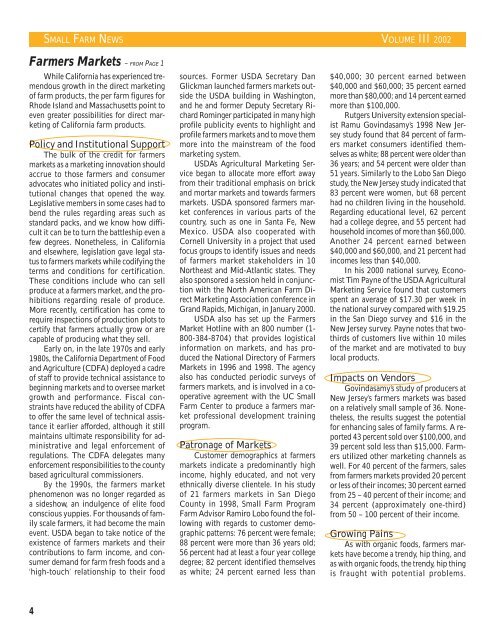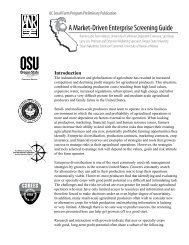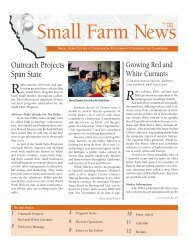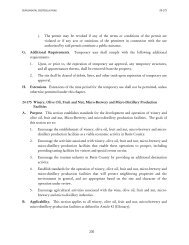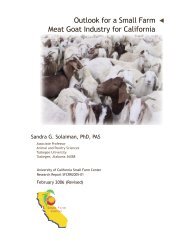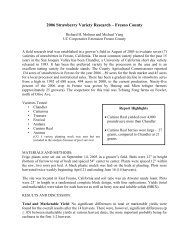Farmers Markets - University of California Small Farm Program - UC ...
Farmers Markets - University of California Small Farm Program - UC ...
Farmers Markets - University of California Small Farm Program - UC ...
You also want an ePaper? Increase the reach of your titles
YUMPU automatically turns print PDFs into web optimized ePapers that Google loves.
SMALL FARM NEWS VOLUME III 2002<strong><strong>Farm</strong>ers</strong> <strong>Markets</strong> – FROM PAGE 1While <strong>California</strong> has experienced tremendousgrowth in the direct marketing<strong>of</strong> farm products, the per farm figures forRhode Island and Massachusetts point toeven greater possibilities for direct marketing<strong>of</strong> <strong>California</strong> farm products.Policy and Institutional SupportThe bulk <strong>of</strong> the credit for farmersmarkets as a marketing innovation shouldaccrue to those farmers and consumeradvocates who initiated policy and institutionalchanges that opened the way.Legislative members in some cases had tobend the rules regarding areas such asstandard packs, and we know how difficultit can be to turn the battleship even afew degrees. Nonetheless, in <strong>California</strong>and elsewhere, legislation gave legal statusto farmers markets while codifying theterms and conditions for certification.These conditions include who can sellproduce at a farmers market, and the prohibitionsregarding resale <strong>of</strong> produce.More recently, certification has come torequire inspections <strong>of</strong> production plots tocertify that farmers actually grow or arecapable <strong>of</strong> producing what they sell.Early on, in the late 1970s and early1980s, the <strong>California</strong> Department <strong>of</strong> Foodand Agriculture (CDFA) deployed a cadre<strong>of</strong> staff to provide technical assistance tobeginning markets and to oversee marketgrowth and performance. Fiscal constraintshave reduced the ability <strong>of</strong> CDFAto <strong>of</strong>fer the same level <strong>of</strong> technical assistanceit earlier afforded, although it stillmaintains ultimate responsibility for administrativeand legal enforcement <strong>of</strong>regulations. The CDFA delegates manyenforcement responsibilities to the countybased agricultural commissioners.By the 1990s, the farmers marketphenomenon was no longer regarded asa sideshow, an indulgence <strong>of</strong> elite foodconscious yuppies. For thousands <strong>of</strong> familyscale farmers, it had become the mainevent. USDA began to take notice <strong>of</strong> theexistence <strong>of</strong> farmers markets and theircontributions to farm income, and consumerdemand for farm fresh foods and a‘high-touch’ relationship to their foodsources. Former USDA Secretary DanGlickman launched farmers markets outsidethe USDA building in Washington,and he and former Deputy Secretary RichardRominger participated in many highpr<strong>of</strong>ile publicity events to highlight andpr<strong>of</strong>ile farmers markets and to move themmore into the mainstream <strong>of</strong> the foodmarketing system.USDA’s Agricultural Marketing Servicebegan to allocate more effort awayfrom their traditional emphasis on brickand mortar markets and towards farmersmarkets. USDA sponsored farmers marketconferences in various parts <strong>of</strong> thecountry, such as one in Santa Fe, NewMexico. USDA also cooperated withCornell <strong>University</strong> in a project that usedfocus groups to identify issues and needs<strong>of</strong> farmers market stakeholders in 10Northeast and Mid-Atlantic states. Theyalso sponsored a session held in conjunctionwith the North American <strong>Farm</strong> DirectMarketing Association conference inGrand Rapids, Michigan, in January 2000.USDA also has set up the <strong><strong>Farm</strong>ers</strong>Market Hotline with an 800 number (1-800-384-8704) that provides logisticalinformation on markets, and has producedthe National Directory <strong>of</strong> <strong><strong>Farm</strong>ers</strong><strong>Markets</strong> in 1996 and 1998. The agencyalso has conducted periodic surveys <strong>of</strong>farmers markets, and is involved in a cooperativeagreement with the <strong>UC</strong> <strong>Small</strong><strong>Farm</strong> Center to produce a farmers marketpr<strong>of</strong>essional development trainingprogram.Patronage <strong>of</strong> <strong>Markets</strong>Customer demographics at farmersmarkets indicate a predominantly highincome, highly educated, and not veryethnically diverse clientele. In his study<strong>of</strong> 21 farmers markets in San DiegoCounty in 1998, <strong>Small</strong> <strong>Farm</strong> <strong>Program</strong><strong>Farm</strong> Advisor Ramiro Lobo found the followingwith regards to customer demographicpatterns: 76 percent were female;88 percent were more than 36 years old;56 percent had at least a four year collegedegree; 82 percent identified themselvesas white; 24 percent earned less than$40,000; 30 percent earned between$40,000 and $60,000; 35 percent earnedmore than $80,000; and 14 percent earnedmore than $100,000.Rutgers <strong>University</strong> extension specialistRamu Govindasamy’s 1998 New Jerseystudy found that 84 percent <strong>of</strong> farmersmarket consumers identified themselvesas white; 88 percent were older than36 years; and 54 percent were older than51 years. Similarly to the Lobo San Diegostudy, the New Jersey study indicated that83 percent were women, but 68 percenthad no children living in the household.Regarding educational level, 62 percenthad a college degree, and 55 percent hadhousehold incomes <strong>of</strong> more than $60,000.Another 24 percent earned between$40,000 and $60,000, and 21 percent hadincomes less than $40,000.In his 2000 national survey, EconomistTim Payne <strong>of</strong> the USDA AgriculturalMarketing Service found that customersspent an average <strong>of</strong> $17.30 per week inthe national survey compared with $19.25in the San Diego survey and $16 in theNew Jersey survey. Payne notes that twothirds<strong>of</strong> customers live within 10 miles<strong>of</strong> the market and are motivated to buylocal products.Impacts on VendorsGovindasamy’s study <strong>of</strong> producers atNew Jersey’s farmers markets was basedon a relatively small sample <strong>of</strong> 36. Nonetheless,the results suggest the potentialfor enhancing sales <strong>of</strong> family farms. A reported43 percent sold over $100,000, and39 percent sold less than $15,000. <strong><strong>Farm</strong>ers</strong>utilized other marketing channels aswell. For 40 percent <strong>of</strong> the farmers, salesfrom farmers markets provided 20 percentor less <strong>of</strong> their incomes; 30 percent earnedfrom 25 – 40 percent <strong>of</strong> their income; and34 percent (approximately one-third)from 50 – 100 percent <strong>of</strong> their income.Growing PainsAs with organic foods, farmers marketshave become a trendy, hip thing, andas with organic foods, the trendy, hip thingis fraught with potential problems.4


